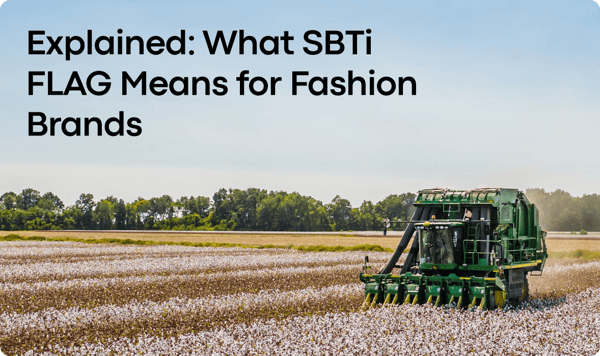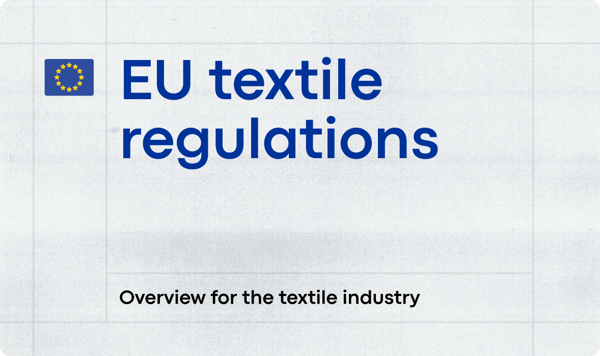Extended Producer Responsibility (EPR) laws, which hold producers accountable for the entire lifecycle of their products, are not new to the textile industry. The landscape, however, is rapidly evolving. While the European Union is at the forefront of implementing such regulations, new initiatives are emerging globally – something fashion and textile brands should be prepared for. This article provides an overview of the existing EPR frameworks for textiles and highlights forthcoming policies worldwide.
First, What Is Extended Producer Responsibility for Textiles?
You’ve probably heard this before: every second, the equivalent of one garbage truck of textiles is landfilled or burned. But it’s worth repeating because the waste generated by the fashion industry is a driving force behind current and upcoming EPR regulations for textiles.
Instead of leaving consumers and the national governments to deal with textile waste, EPR places this responsibility on the producers. Fashion brands are held accountable for their products throughout their lifecycle – which includes end-of-life too. This refers to waste collection, recycling, and final disposal of their textiles and footwear.

What Are the Textile EPR Requirements?
The specific requirements can vary depending on the country, but they generally include several key elements such as:
- Reporting on the quantities or weight of clothes placed on the market, material type, end-of-live management data, waste treatment processes.
- Participation in take-back schemes for waste collection.
- Fee payment per unit or weight of textiles placed on the market, which helps fund waste management and recycling systems.
- And lastly, eco-modulation.
Eco-modulation refers to the practice of adjusting the fees that producers pay under EPR schemes based on the environmental impact of their products. In the textile industry, eco-modulation incentivizes companies to design, produce, and sell more sustainable textiles by modulating (increasing or decreasing) the fees they pay according to specific environmental criteria. According to these criteria, the eco-friendlier the textile product is, the less the producer pays.
The idea is to encourage apparel and footwear brands to think about product impact right from the design phase. This involves integrating sustainable practices into their operations, such as using recyclable materials, designing products for durability, and facilitating end-of-life garment recycling – ultimately leading to products that are more eco-friendly and easier to recycle.
So what about waste collection? Well, apparel and footwear brands need to both handle the waste collection operationally, and also report in each country separately.
For waste collection, brands can become members of a Producer Responsibility Organisation (PRO) in each country, which are organizations that handle the logistics and systems needed to collect old clothing or textiles, making sure they are properly recycled or disposed of. Even if this isn’t mandatory in a given individual EU-member state, it’s advisable to become a member of a PRO, else brands will have to organize their own waste end-of-life processes such as waste collection.
What Data Do You Need for EPR Reporting?
Currently, every EU country will have its own textile EPR scheme. However, the only EU countries that have it in force currently are Hungary, Latvia, France and the Netherlands.
In some countries, it will require fashion brands to report the weight of products (instead of per unit) they place/sell in this market – and that’s a big challenge. Most brands don’t know the component weights for their textile products, and on top of that they have to combine sales and product data for reporting, which can be quite time-consuming.
.png?width=2000&height=1144&name=1%20(2).png)
EPR for Textiles in the European Union
Let’s have a look at the legal basis of the EU legislation and the individual obligations in the different EU member states.
EU Waste Framework Directive (WDF)
Status: Approved Law
The Waste Framework Directive (WFD) was adopted in 2021. A key component of this directive is the EPR – short for Extended Producer Responsibility, under which member states must establish their own legal frameworks and laws, ensuring producers are responsible for the entire lifecycle of their products.
The WFD requires all EU Member States to establish separate textile waste collection systems by January 1, 2025, requiring municipalities to separate textiles from general waste. However, there is no exact deadline for implementing EPR systems, and it will depend on the final adoption date of the proposed amendment.
Amendment of the Waste Framework Directive (WDF)
Current Status: Proposal stage
In 2023, the European Commission proposed an amendment to the Waste Framework Directive, targeted to the textile industry. There are currently numerous EPRs in use across the different Member States, which makes compliance and reporting very complicated, and the goal of this new regulation is to harmonize them.
The amendment will facilitate the sustainable management of textile waste across the EU, making textile producers responsible for the costs of textile waste management. The goal is to encourage them to reduce waste and increase the circularity of their products. Once producers are responsible for covering the cost of textile waste management, they will have a fresh incentive to reduce waste and make their products more circular.
How much will it cost? The fee will be based on “eco-modulation” which we talked about before. In other words, the overall environmental performance of the textile.
Here are the key elements:
- Mandatory EPR Schemes: All EU Member States must implement Extended Producer Responsibility (EPR) systems for textiles, making producers responsible for the entire lifecycle of their products, from production to waste management.
- Modulated EPR Fees: Producers will pay fees based on the environmental impact of their products. More sustainable, durable, and recyclable products will incur lower fees.
- Waste Management Obligations: Producers must finance collection, reuse, and recycling of textile waste, contributing to EU-wide reuse and recycling targets.
- Reporting Requirements: Producers must report the volume of textiles they place on the market and their contributions to waste management.
- Cross-Border Compliance: Harmonized EPR rules across the EU aim to reduce fragmentation and administrative burdens for companies operating in multiple Member States.
The following product categories are included:
Textile Products
- Knitted or crocheted clothing and accessories
- Non-knitted clothing and accessories
- Blankets and travelling rugs (except electric blankets)
- Bed linen, table linen, toilet linen, kitchen linen
- Curtains, drapes, and interior blinds
- Curtain or bed valances
- Other furnishing articles (excluding mattresses)
- Worn clothing and other worn articles
- Hats and other headgear made from plaited strips
- Knitted or crocheted hats, lace or felt headgear, and hairnets
Non-Textile Apparel & Footwear
- Leather clothing and accessories
- Waterproof footwear made from rubber or plastics
- Footwear with rubber/plastic soles and uppers
- Footwear with leather soles and uppers
- Footwear with textile uppers
- Other types of footwear
We expect the amendment to be approved in Mid to Late 2025. Then EU membership states have 18 months to transpose into national law. These EPR schemes must be in place 18 months after the directive is approved.
Read the details on the revision of the Waste Framework Directive
Several countries have already implemented different textile EPR regulations. Here are the key requirements of current active textile Extended Producer Schemes per EU country:
France – Textile EPR Requirements
France was the pioneer in implementing EPR when it began enforcing this legislation in 2007.
In 2020, the AGEC law extended the scope of the EPR definition of producer and introduced new obligations:
- Expansion of EPR to Textiles: Fashion brands must finance the collection, sorting, reuse, and recycling of post-consumer textiles, shoes, and household linen.
- The destruction of unsold textiles and footwear is prohibited, with the intent to promote reuse, donation, or recycling.
- Data Reporting on Volumes: Apparel and footwear companies must report the number of textile items placed on the French market annually, broken down by product type (e.g., apparel, footwear, home textiles).
- Reporting on Recycled and Recyclable Content: Clothing brands are required to disclose the percentage of recycled fibers used in their products and whether the items are designed for recyclability.
- End-of-Life Management Data: Fashion Brands must report on collected, reused, and recycled quantities of their products, including details on how waste is processed (e.g., donation, recycling, incineration).
- Eco-Modulation Data: Brands must provide eco-design information, including the presence of hazardous substances and the durability or repairability of products to adjust EPR fees based on environmental performance.
France’s textile EPR rules apply to any company selling products on the French market. While some companies have implemented custom take-back programs, nearly all others utilize the Refashion collective compliance scheme, which operates a network of textile collection points throughout the country. Refashion is a so-called Producer Responsibility Organization (PRO) With an EPR fee structure, France is already ahead of the EU in this regard. It is based upon eco-modulation, with a maximum of €0.06 and an average of €0.01 per garment.
Generally, all textile, footwear, and household linen products are included, however there are two notable exceptions:
- 100% leather or natural fur garments are not subject to the regulation.
- Products made from 100% upcycled materials that have already contributed to EPR are also excluded from the regulation.
Practically this means that fashion brands selling into the French market are required to submit an annual declaration to Refashion, detailing the quantities of clothing, household linen, and footwear they have placed on the French market in the previous year. The deadline for this declaration is typically February 29 of each year. They are also required to display the Triman Logo and sorting instructions on relevant products, guiding consumers on proper recycling methods.
In France, eco modulation incentivizes environmentally friendly product design by adjusting fees based on specific criteria. As of 2025, the following eco-modulation measures apply:
- Bonuses:
- Product Durability: Products demonstrating enhanced physical durability, as defined by specific criteria per product type, are eligible for bonuses. The bonus amount is calculated by multiplying a reference amount (€0.70 or €0.07, depending on the volume placed on the market) by a factor specific to each of the 11 product categories concerned.
- Environmental Certifications: Finished products certified by recognized environmental labels (e.g., GOTS, Oeko-Tex® Made in Green) receive bonuses. The bonus paid for each style is €0.30 or €0.03, depending on the volume placed on the market and the product category (Clothing, Household linen, Footwear).
- Incorporation of Recycled Materials: Products incorporating recycled materials from post-consumer textile waste collected or funded by an approved producer responsibility organization are eligible for bonuses. The bonus amounts are €1,000 per tonne for materials from closed-loop recycling and €500 per tonne for materials from open-loop recycling.
- Penalties:
- Recyclability Issues: Products containing metalloplastic fibers or electronic/electrical components (excluding traceability devices) incur penalties due to recycling challenges. The penalty amount varies by product line, as detailed in the nomenclature.
-
Specific Forms and Templates:
-
Refashion provides specific forms and templates for reporting eco-modulation data. These forms will require detailed information about each product and the relevant criteria. Brands must also submit a waste prevention and eco-design plan, templates can be found on Refashions website.
-
You can find details in Refashion’s Eco Modulation guide. Eco-modulation reporting is typically done through Refashion's dedicated online platform.
The Netherlands – Textile EPR Requirements
Since July 2023, producers, importers, and manufacturers of consumer clothing, work and corporate wear, bed-, table-, and household linen - though not footwear, headwear, belts, bags, blankets, or curtains - are subject to the EPR decree. The rules apply to both Dutch and foreign fashion brands. Foreign companies are required to designate an “Authorized Representative” (PRO) to help meet EPR requirements.
Stichting UPV Textiel is the main PRO in the Netherlands that supports apparel brands and importers of clothing and textiles in their EPR obligations. On behalf of participating clothing brands, the organization will collectively organize the collection, reuse, and recycling of discarded textiles. Additionally, brands have reporting obligations designed to achieve their reuse and recycling targets, need to declare quantities of products placed on the Dutch market, and pay an annual fee.
Under the Dutch EPR decree, textile producers must establish free-of-charge collection systems for consumers. They will also be required to prepare a percentage of collected textiles for recycling and reuse, ensuring a portion of the waste is repurposed through fiber-to-fiber recycling processes. There are three main targets for 2025:
- 50% of textiles sold must be prepared for reuse or recycling, increasing gradually to 75% by 2030.
- 10% of textiles sold must be reused within the Netherlands, rising to 15% by 2030.
- 25% of recycled textiles must undergo fibre-to-fibre recycling, with a target of 33% by 2030
The Netherlands, like France, has an EPR fee for textiles. From January 1 to July 1, 2025, there will be no fee. Following this period, the fee will increase to €0.24 per kilogram of textiles, based on the total weight for the year 2025. This fee is calculated pro rata for the remaining part of the year. The advice is to take into account an average fee of € 0.12 per kilogram on an annual basis.
Each year, before April 1, fashion brands must declare the total weight of textiles that they plan to sell on the market in the Netherlands in the upcoming year. Based on this statement, they will pay a provisional fee. In the following year, brands need to submit the actual sales for the previous calendar year before April 1. The difference in fee is then settled.
Fashion brands can sign up with Stichting UPV Textiel and find a template for the Dutch EPR report in “Textool” report.
Hungary - Textile EPR Requirements
Hungary introduced Extended Producer Responsibility (EPR) for textiles in July 2023, requiring obligated companies to register with the National Waste Management Authority by May 31, 2023. The scope of Hungary's Textiles EPR includes apparel, clothing accessories, household linens, curtains, blankets/rugs, footwear, and carpets.
Under this system, fashion brands must make EPR contributions on a quarterly basis. To date, the cost for compliance is set at HUF 145 ($0.42) per kilogram of textiles.
These obligations apply to both Hungarian and foreign companies. And, like The Netherlands, foreign apparel brands can appoint a national “Authorized Representative” to fulfill their EPR obligations. Brands are required to register with the PRO, MOHU and submit regular reports on the weight of textiles placed on the Hungarian market.
Latvia - Textile EPR requirements
Latvia requires a fee of €0.50 per kilogram with similar weight-based reporting as Hungary. Latvia offers a reduced fee of €0.13 / per kilogram once registered with Latvia’s national scheme.
Products included are clothes, clothing accessories, shoes and household textiles.
Companies must either pay the “Natural Resource Tax” to the government or join a PRO to take on this obligation for them, and thus be exempt from paying the tax. In that case, companies would have to pay EPR fees to a PRO instead.
The main PRO in Latvia is called Latvijas Zalais Punkts, abbreviated to LZP.
Non-EU Countries With Active EPR Regulations
Australia
Australia currently operates a voluntary EPR program, known as the Seamless Clothing Stewardship Scheme, which became active on July 1, 2024. However, the government has stated that if participation by textile companies remains low, it will move to make the program mandatory. The scheme aims to achieve clothing circularity and reduce 200,000 tons of annual textile waste in Australia by 2030.
The scheme asks companies to impose a four-cent levy per garment to fund programs that foster the design of more durable and recyclable clothing. It will also help finance the expansion of textile collection, sorting, and recycling infrastructure.
Upcoming EPRs around the world
Sweden
The Swedish EPR was meant to go into effect in 2022 and would give affected companies two years to comply. To date, the government is still in the process of implementing the bill, making the compliance timeline unclear. We’ll focus on what’s contained in the legislation here.
The scheme will apply to all clothes, household textiles, bags, and accessories. There is one notable exemption: producers who create products using >80% textile waste. Regulations will apply to both Swedish and foreign companies, with those based outside of the country obligated to designate an “Authorized Representative.”
Sweden aims to reduce textile disposal by:
- 70% in 2028
- 80% in 2032
- 90% in 2036
Like other countries, companies will be required to ensure that waste collection points are easily accessible. The country is particularly keen to increase textile recycling and reuse.
Spain
Spain's Waste & Contaminated Soil for the Circular Economy law has been approved and will come into effect in 2025. Under this regulation, companies will be required to register and obtain an EPR (Extended Producer Responsibility) number, pay periodic fees, and submit reports. Both Spanish and foreign companies, as well as online marketplaces facilitating the shipment of textiles to Spain by foreign sellers, will be subject to this law.
In April 2025, a pilot scheme for textile waste collection will commence, lasting one year. The results of this pilot will be evaluated to produce recommendations and guidelines for effective waste collection. This initiative precedes the implementation of National Law No. 7/2022 on Waste and Contaminated Soils for a Circular Economy, which mandates the development of an EPR system for textiles within three years of its entry into force. According to reports, a Royal Decree addressing the EPR framework is expected no earlier than spring 2025, though potential delays may arise to align with anticipated changes at the EU level. We will provide updates as new developments occur.
California
In September 2024, California passed the Responsible Textile Recovery Act, making it the first American state to enact EPR legislation. The Act requires textile producers to join an approved producer responsibility organization (PRO). These organizations will need to submit a plan for the collection, transportation, repair, sorting, and recycling of apparel and textiles in the state.
The “producer” is defined as the person or company responsible for covered products. California has introduced a tiered approach:
- The manufacturer of a product who owns or licenses the brand or trademark under which it is sold.
- The brand owner or exclusive licensee if no such manufacturer exists in California.
- The importer of a product if neither the manufacturer nor licensee are present.
- If none of the above are present in the state, the distributor, retailer, or wholesaler selling the product is responsible.
*Sellers of secondhand products or who have less than $1 million annual revenue are exempt.
In terms of timeline, California’s Responsible Textile Recovery Act requires all producers to join a PRO by July 1, 2026.
Drafted and Planned EPR Regulations
In addition to these laws, there are numerous other countries revving up to introduce EPRs of their own. Among them are Italy, Chile, and Norway. The United Kingdom stands out as a notable exception, especially as one of the largest textile consumers in the world. While the country has expressed interest in implementing an EPR for textiles, progress has been delayed until at least 2025. The government is still evaluating the scheme, but no clear timeline has been set. Given the delays in implementing EPR for packaging, it is likely that a textile EPR may not be introduced until after 2025.
Here's a revised pitch, incorporating your preferences and Carbonfact's value proposition:
Simplify EPR Compliance with Carbonfact
Extended Producer Responsibility (EPR) reporting presents a significant challenge for brands, not only because of the administrative burden – gathering accurate data is also a complex endeavor. Many brands struggle to determine the weights of product components, identify fiber compositions, and link this product data to sales data for reporting purposes.
How Carbonfact Helps
Carbonfact transforms this challenge into an opportunity by providing tools that streamline EPR compliance while driving cost savings and impact reductions. Here's how:
- Link Product and Sales Data
Our platform connects your product specifications - including detailed fiber compositions and component weights - with sales data, ensuring accurate and complete EPR reporting. - Reduce Costs with Eco Design
Carbonfact’s eco-design tools allow you to analyze your product portfolio for the amount of recycled material used. This can lead to substantial cost savings through eco-modulation, where products with higher recyclability incur lower EPR fees as you optimize your product range. - Get Ahead of Regulatory Deadlines
If the WFD revision is approved, brands will have just 18 months to comply. Early data preparation is key. Carbonfact ensures you’re ready by ingesting, cleaning, and enriching the data you have so you can become compliant without having to become a data administrator.
Why Act Now?
EPR isn’t just about reporting – it’s about aligning with the market shift toward circularity. Carbonfact equips you with the data, insights, and tools to not only meet compliance requirements but create significant cost savings through eco-modulation.





![[Guide] Carbon accounting for fashion, textile, apparel, and footwear companies](https://www.carbonfact.com/hs-fs/hubfs/CA%20-%20Opt1.png?width=600&name=CA%20-%20Opt1.png)
 Angie Wu
Angie Wu

 Lidia Lüttin
Lidia Lüttin
